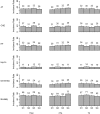Thyroid function in the euthyroid range and adverse outcomes in older adults
- PMID: 25514105
- PMCID: PMC4333030
- DOI: 10.1210/jc.2014-3586
Thyroid function in the euthyroid range and adverse outcomes in older adults
Abstract
Context: The appropriateness of current reference ranges for thyroid function testing in older adults has been questioned.
Objective: This study aimed to determine the relationship between thyroid function tests within the euthyroid range and adverse outcomes in older adults not taking thyroid medication.
Design, setting, and participants: US community-dwelling adults years of older (n = 2843) enrolled onto the Cardiovascular Health Study with TSH, free T4 (FT4), and total T3 concentrations in the euthyroid range.
Main outcome measures: Incidence of atrial fibrillation, coronary heart disease, heart failure, hip fracture, dementia, and all-cause death were measured.
Results: No departures from linearity were detected. Higher TSH was negatively associated (P = .03) and higher FT4 was positively associated (P = .007) with mortality. Higher FT4 was associated with atrial fibrillation (P < .001) and heart failure (P = .004). Compared with the first quartile, individuals with TSH in the fourth quartile had a 9.6 per 1000 person-year lower incidence of dementia (P < .05) and those with FT4 in the fourth quartile had higher incidences of atrial fibrillation, coronary heart disease, heart failure, and mortality (11.0, 8.0, 7.8, and 14.3 per 1000 person-years, respectively, all P < .05). Total T3 was not associated with any outcome.
Conclusions: Higher TSH and lower FT4 concentrations within the euthyroid range are associated with lower risk of multiple adverse events in older people, including mortality. This suggests tolerance for lower thyroid hormone levels in this age group. Clinical trials are needed to evaluate the risk-benefit profile of new thresholds for initiating treatment and optimal target concentrations for thyroid hormone replacement in older people.
Figures


References
-
- Cooper DS, Biondi B. Subclinical thyroid disease. Lancet. 2012;379:1142–1154. - PubMed
-
- Bauer DC, Ettinger B, Nevitt MC, Stone KL. Risk for fracture in women with low serum levels of thyroid-stimulating hormone. Ann Intern Med. 2001;134:561–568. - PubMed
-
- Vadiveloo T, Donnan PT, Cochrane L, Leese GP. The thyroid epidemiology, audit, and research study (TEARS): Morbidity in patients with endogenous subclinical hyperthyroidism. J Clin Endocrinol Metab. 2011;96:1344–1351. - PubMed
Publication types
MeSH terms
Grants and funding
- N01 HC085080/HL/NHLBI NIH HHS/United States
- U01 HL080295/HL/NHLBI NIH HHS/United States
- N01 HC085082/HL/NHLBI NIH HHS/United States
- K24AG042765/AG/NIA NIH HHS/United States
- K24 AG042765/AG/NIA NIH HHS/United States
- R01AG032317/AG/NIA NIH HHS/United States
- HHSN268201200036C/HL/NHLBI NIH HHS/United States
- N01 HC055222/HL/NHLBI NIH HHS/United States
- N01 HC085079/HL/NHLBI NIH HHS/United States
- R01 HL080295/HL/NHLBI NIH HHS/United States
- HHSN268201200036C/HL/NHLBI NIH HHS/United States
- HL080295/HL/NHLBI NIH HHS/United States
- R01 AG023629/AG/NIA NIH HHS/United States
- N01 HC085081/HL/NHLBI NIH HHS/United States
- N01 HC55222/HC/NHLBI NIH HHS/United States
- HHSN268200800007C/HL/NHLBI NIH HHS/United States
- N01 HC085086/HL/NHLBI NIH HHS/United States
- N01 HC085083/HL/NHLBI NIH HHS/United States
- R01 AG032317/AG/NIA NIH HHS/United States
- HHSN268200800007C/HL/NHLBI NIH HHS/United States
- AG023629/AG/NIA NIH HHS/United States
- R56 AG023629/AG/NIA NIH HHS/United States
LinkOut - more resources
Full Text Sources
Other Literature Sources
Medical

